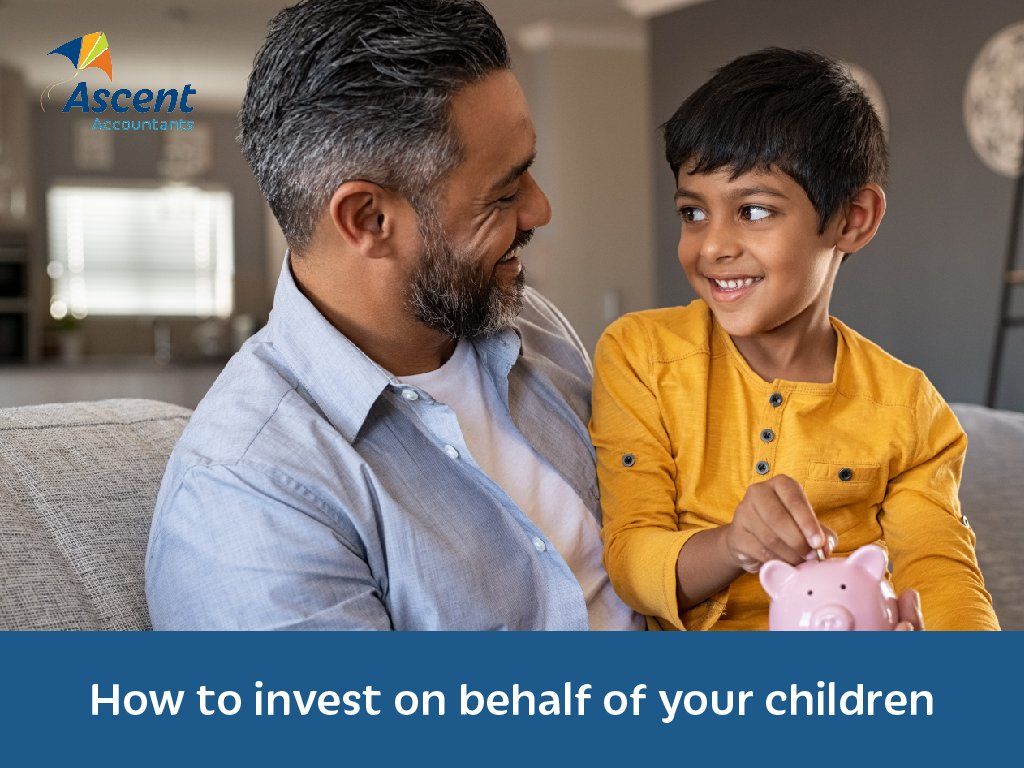How to invest on behalf of your children

As a parent, there’s an almost supernatural maternal desire to nurture and protect your children as you raise them. In doing all we can for our children, we also have a deep-rooted instinct to help them succeed in life. A part of this comes down to being financially secure and self-sufficient, which leaves a lot of parents wondering how to invest on behalf of their children.
There are lots of ways you can tackle this, and each strategy has its own set of pros and cons. But, before we get into it, this article assumes you’re financially secure yourself and have the means to invest on behalf of your children. Remember, investing always carries some level of risk, so it should be considered a “luxury”, not a way to quickly create a financial source for your child.
Now that that’s out of the way, let’s explore the do’s and don’ts of investing on behalf of your child.
1. Investing in the right name.
Don’t invest in your child’s name.
If you’ve never done this before, it’s tempting to just invest in your child’s name, but just because you can, doesn’t mean you should. Typically, it is not a good idea to hold investments directly in the name of a child under the age of 18, unless it is just a little bit of cash in a savings account. This is simply because of tax. In Australia, they can only earn $416 per financial year tax-free and if they exceed this, hefty tax rates as high as 66% may incur.
These tax rates for minors exist to stop wealthy people from holding assets in their children's names to avoid tax. However, certain income sources are exempt from these high tax rates. This includes income generated from the proceeds of an inheritance and earned income, or if the child has a disability. It is also very hard (almost impossible!) to buy growth assets, like shares, directly in the name of a minor.
Do invest in your own name.
The straightest path is simply investing in your own name and then gifting the assets later. This strategy is most effective when you (or your spouse) have a low marginal tax rate or low taxable income. This is because any investment earnings will be taxed in the name of the owner.
Using this method, an adult is subject to the standard marginal tax rates, as opposed to minor tax rates. Also, you can invest in basically anything.
There is a downside… When you gift the asset to your child the ownership changes, you’ll trigger a capital gains tax (CGT) event. This means that without proper tax planning, you could end up with a big tax big upon gifting the asset to your child. The tax will be bigger if you’ve been investing over an extensive period. There are ways to mitigate the tax liability, which is something you can discuss with us at Ascent Accountants.
2. Informal trusts.
Investing through an informal trust is similar to investing in your own name. But, instead of owning the asset in your name, you own the asset in your name "as trustee for" the child. There are several online broker accounts and managed funds that will allow you to own assets under an informal trust, which makes your investment options with this strategy very flexible.
Just remember that if the asset that you’re investing in produces income, the income will still be taxed in the parent's name at their marginal tax rate. So, it’s a good idea to invest via an informal trust in the name of the parent with the lowest taxable income.
In any case, when the child turns 18, you can transfer the ownership of the shares to the child and not trigger a CGT event (like we mentioned in point two). Instead, the child will inherit the original cost base. This is possible because — according to the ATO — under an informal trust, the beneficial owner is the child as the assets have been owned "as trustee for".
3. Investment/insurance bonds.
An investment bond (also called an insurance bond) is kind of like a superfund in that it’s a separate structure with its own set of rules. Investment bonds have a flat tax rate of 30%. This means that all income and capital gains made within the bond are taxed at 30%. So, this is advantageous if both parents' marginal tax rates are above 30%.
Investment bonds are also a "tax paid" investment. This means all income and capital gains are taxed within the bond, which is great because when it comes to lodging your tax return, there’s nothing you need to declare. Why? It’s all been accounted for inside the bond, which provides a streamlined experience.
When you hold investment bonds for the long-term (we’re talking 10+ years), your investment becomes 100% CGT free. This is a massive benefit for those looking to invest over a long period of time.
We’ve packed investment bonds in a nutshell here, but they certainly have their complications and complexities. If you understand investment bonds — or have the time to understand them — this can be a great investment strategy. If not, it’s probably not the right one for your family.
4. Discretionary family trust.
This one is a big jargon-y, so hold onto your hats (and if you want to discuss it more, you can always call us!). Of all the structures we’ve talked about so far, a discretionary family trust is the most flexible from a tax and investment perspective. For example, you can invest in any asset class you like via the trust and investment returns are distributed at the trustee's discretion.
Speaking of trustees, when you set up a family trust, you act as trustee. This could be yourself as an individual trustee or as a director of a corporate trustee. The assets are owned by you as trustee for the family trust.
Each financial year, income and capital gains are distributed to the beneficiaries of the trust, at the trustee's discretion (that’s a pretty powerful position!). This gives you the ability to distribute income differently each year depending on your family members' marginal tax rates. See? We told you it was flexible. You could do it in a single year, over multiple years or even set them up a regular income stream from the trust. Beneficiaries usually include any family member (e.g. your children) or companies and other trusts run by family members.
So, why doesn’t everyone use this structure? Family trusts can be expensive to setup and operate. As such, we don’t recommend this strategy unless you have some serious assets to invest — like, a minimum of $100,000 before you even consider it.
5. Superannuation.
Superannuation is a common investment option and generally the most tax effective structure. Investing as a superfund has its own tax rate of 15%, which is typically a lot lower than the average person's marginal tax rate.
Like all these strategies, there’s always a downside (or more than one), and for superannuation, there’s a pretty big one. Your child must meet a condition of release before they can access the funds. Typically, this has always been retirement, and the maximum preservation age for retirement is currently 60. That’s a pretty long time away for your child…
Under the first home super saver scheme, you can make voluntary contributions to super of up to $15,000 per financial year and $30,000 in total and use those contributions as a deposit on your first home. How’s that relevant? Well, if you intend to help your child purchase their first house (which is a reason many parents start investing on behalf of their children), this strategy can help you do that.
You can also use this strategy to help set them up for the long-term, for example, having a comfortable retirement. If you invested $10,000 in a superfund for a 15-year-old child, and earn 6% p.a. on the money (after fees and taxes), then by the time your child reaches age 60 that $10,000 could be worth $148,000.
Whilst many people can make this strategy work, it’s certainly one where you’re in it for the long haul, and for some people, this is off-putting. For example, you may never see the fruits of your investments or know if it was successful. The extensive time period leaves a lot that’s subject to change — for example, tax laws are always evolving and this could impact your investment. Even so, it’s worth exploring if you’re feeling like this could be the right option for you.
When it comes to investing, invest in professional support.
Like all big decisions — especially financial decisions — there’s a lot to consider. So, here are four points we think you should mull over.
1. How long do you plan to invest for?
2. What do you want to invest in?
3. What investment strategy will be most effective for your family?
4. What will be the tax consequences of your chosen strategy?
We’re ready to talk when you are. Contact us to learn more about investment options and the tax implications for each.
Need help with your accounting?








